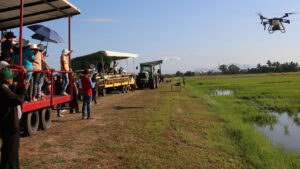(First of two parts)
There is a risk, as one keeps track of the country’s macroeconomic health, of being jaded about agriculture’s consistently dismal performance, a result of decades of policy missteps.
The farm sector’s trajectory has always been sub-par compared to services and industry, even if manufacturing — which makes up about three-fifths of the “industry” sector tracked by the Philippine Statistics Authority — struggles with repercussions of its own past policy blunders. Agriculture, forestry and fisheries (AFF) as a sector contributes an incrementally smaller percentage to national output (as measured by gross domestic product, or GDP) at less than 10% currently — the smallest among the three growth drivers, even as its contribution to overall employment has steadied at around a fourth of the total. “Given the sector’s slow growth and modest share to GDP, and its relatively high contribution to total employment, AFF’s development significantly lagged behind the other sectors as measured by labor productivity (measured by the ratio of the sector’s share to output vis-a-vis employment),” read a paper which Dr. Fermin D. Adriano, formerly Agriculture secretary for policy, planning, and research and now columnist for The Manila Times, presented to the Australian National University in October last year.
Hence, agriculture has always been that missing ingredient for faster overall economic expansion — of at least about 8%, according to one of BusinessWorld’s columnists, Dr. Bernardo M. Villegas, compared to the around 6% actually clocked in recent years — that is needed to generate more jobs and economic opportunities that can make a dent on the grinding poverty that has always marred our growth picture. Mr. Villegas has often written on agriculture-related issues for this publication, like the link between farm development and manufacturing (https://tinyurl.com/22u79vpk), the need to upskill agribusiness executives (a three-part series starting with https://tinyurl.com/2bces9ku) and a comprehensive agribusiness situationer (starting with https://tinyurl.com/ynvauzqn), among others.
Which is why farmers always come to mind whenever I hear of technologies’ potential to simplify processes, enhance efficiencies and, thus, increase productivity… and, ultimately, to change lives. Farming communities are also a logical key target for any anti-poverty drive, since much of Philippine poverty is concentrated in rural areas.
One does not need to travel far to realize just how much our farmers have been left behind: just take a trip outside Metro Manila and see if one can spot tractors at work on any farmland. Small farmers, who make up the majority of our agriculture sector, still rely on manual labor and draft animals to get the work done.
And so, any news on new technologies that can help these folks produce more by working more efficiently and, therefore, earning more while hopefully helping to reduce prices of produce, always catches my attention.
Agriculture technology, according to one primer of the US Agriculture department’s National Institute of Food and Agriculture, enables farmers to use just the right amounts of water, fertilizer, and pesticides on specific areas and even individual plants, instead of applying them uniformly across entire fields. This, in turn, increases crop productivity; reduces water, fertilizer, and pesticide use, which in turn keeps a lid on food prices; minimizes impact on natural ecosystems, including chemical runoff into rivers and groundwater; and enhances worker safety.
SEND IN THE DRONESTake the current initiative to use drones on rice and tobacco fields, for example.
The National Tobacco Administration (NTA) announced in December last year that it had deployed drones at its eight provincial branch offices as well as its Farm Technology and Services Department. The NTA used drones to validate the state of 22,073.09 hectares (ha) in Luzon planted by 36,102 farmers with Virginia, Burley, and Native tobacco types. The office has also begun deploying drones in select areas in Mindanao.
“With the high-resolution aerial imaging and geospatial analysis captured by drones, the area of the tobacco plantations will accurately measure and become the basis for the computation of the volume of production,” the statement quoted NTA Administrator Belinda S. Sanchez as saying.
Meanwhile, Bayer Crop Science demonstrated drone seeding in a rice field in Barangay Sapot in Paniqui, Tarlac in November 2021. The cost of drone seeding was placed at P3,000 per hectare, compared to the labor cost of transplanting rice that ranged from P11,000-P13,000/ha, the company said in a press statement back then. It took just 30 minutes to seed one hectare via drone, compared to half to a whole day if this were done manually. Moreover, this method proved more efficient, with seeding rate averaging 20-25 kilograms of hybrid rice seeds/ha via drone, compared to 40-45 kgs via manual seeding.
Then there is the Drone4Rice project of the International Rice Research Institute (IRRI), done in collaboration with various offices of/attached to the Agriculture department (DA) like the Philippine Rice Research Institute and the Fertilizer and Pesticide Authority (FPA), etc. The project is running for 30 months from April 2024 to September 2026. It will focus on selected organized farms in Cagayan Valley, Calabarzon, and Bicol. Protocols are being drawn up for processes like the accreditation of commercial drone operators that will offer their services. The project aims to cover a total of 150,000 ha per crop season (there are 4.82 million ha planted with palay nationwide). Qualified beneficiaries belonging to irrigators’ associations, small water irrigation system associations, agrarian reform beneficiaries’ organizations, as well as farmers’ cooperatives and associations can tap subsidies amounting to P2,000/ha via vouchers. The National Rice Program has allotted some P300 million for the commercial use of drones for this purpose.
In a press conference in November last year on this project, FPA Officer-in-Charge Glenn DC. Estrada — at that time director for Digitalization and Value Chain Development of the DA’s Masagana Rice Industry Development Program — said that the use of drones is expected to cut farmers’ time, effort, and cost to sow seeds, apply fertilizer, and spray pesticides. “Based on studies, optimal resource allocation leads to better productivity,” he explained.
IRRI said in a statement in April last year that one of the reasons for the huge difference in rice production cost between the Philippines and major rice exporting countries is labor cost, which makes up about a third of the total rice production cost. Noting that mechanization and a shift toward precision agriculture can significantly cut rice production cost, IRRI Senior Scientist Stephen Klassen explained: “Precision agriculture, including the use of drone technology, can optimize input usage like seeds, fertilizers, and pesticides, leading to higher yields and cost efficiency.”
READINESS IN QUESTIONWhile we eagerly await the results of these initial moves, I should think that the government’s agriculture policy makers have already been exchanging notes with counterparts among the conglomerates that have invested in this field — San Miguel Corp., First Pacific, the Aboitiz Group, and DMCI Holdings, Inc., among others — because I have heard that some of them have their own stories to tell about challenges faced in getting farmers they have contracted to embrace new technologies. That’s a whole cache of valuable empirical knowledge just waiting to be tapped right there.
While the nature of hurdles may be varied, one could be the simple fact that our farmers are among the oldest in Southeast Asia, with an average age of 57 years (although updates to the Agriculture department’s data show this could be declining slightly to about 49-50). This means they may have more difficulty or less willingness (or both) to adopt new technologies, which entail new ways of working.
One paper that was published in the International Journal of Social and Management Studies in 2022 noted works of various scholars saying that farmers’ way of life and traditional practices “exerted a disruptive influence on the modernization process” and that these same factors “have been found to significantly influence [technology] adoption decisions,” even as others noted that “[E]ducated farmers tend to be more productive since they are receptive to new technology,” and that “Philippine farmers seem to recognize the many advantages of using farm machines over manual, even if these are costly and will certainly displace laborers,” and that subsistence farmers (who make up bulk of Philippine farmers) who tend to retain labor-intensive practices are “risk-averse due to several constraints such as fears of economic risk, high collateral requirements and social fears… even if, hypothetically, the given costs and benefits are in their favor.”
Other scholars cited in that same paper noted that Filipino farmers, generally do not oppose innovation and actually understand the importance of new technologies in farming. What holds them back is the potential financial risk, especially since farmers are some of the poorest in the country and, hence, have limited options in case new technologies fail them.
(To be concluded on March 6.)
Wilfredo G. Reyes was editor-in-chief of BusinessWorld from 2020 through 2023.






